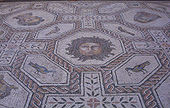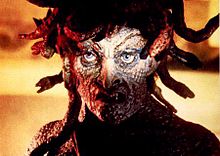- Cultural depictions of Medusa and Gorgons
-
 The Gorgoneion was often placed at the entrance of a building, as in this Roman mosaic from Palencia (2nd century CE)
The Gorgoneion was often placed at the entrance of a building, as in this Roman mosaic from Palencia (2nd century CE)
The mythological monster Medusa and other Gorgons have featured in art and culture from the days of ancient Greece to the modern day. She has been variously portrayed as a monster, a protective symbol, a rallying symbol for liberty and a sympathetic rape victim.
Perhaps best-recognized by her head of living snakes and ability to turn living creatures to stone, Medusa is an ancient icon that remains "one of the most popular and enduring figures of Greek mythology" and "continues to live on in the popular imagination" though other figures are forgotten.[1]
Her likeness has been immortalized by numerous artists including Leonardo da Vinci, Peter Paul Rubens, Pablo Picasso, Auguste Rodin and Benvenuto Cellini.[2]
Contents
Ancient times to Renaissance
The Medusa or Gorgon head, the Gorgoneion, was used in the ancient world as a protective apotropaic symbol. Among the Ancient Greeks, it was the most widely-used image intended to avert evil. Medusa's goggling eyes, fangs and protruding tongue head were depicted as mounted on the shield of Athena herself.[3] Its use in this fashion is depicted in the Alexander Mosaic, a Roman mosaic (ca. 200 BC) in Pompeii. In some cruder representations, the blood flowing under the head can be mistaken for a beard.
By the Renaissance, artists depicted Medusa's head held aloft by the realistic human form of the triumphant hero Perseus (such as in the 1554 bronze statue Perseus with the Head of Medusa by Benvenuto Cellini) or evoked horror by making Medusa's detached head the main subject (as demonstrated by the 1597 painting Medusa by Baroque originator Caravaggio).[4]
19th century
After the French Revolution, Medusa was used as a popular emblem of Jacobinism and was often displayed as a figure of "French Liberty" in opposition to "English Liberty," personified by Athena (whose shield bore Medusa's head).[5] "To radicals like Percy Bysshe Shelley, Medusa was an "abject hero," a victim of tyranny whose weakness, disfiguration, and monstrous mutilation become in themselves a kind of revolutionary power."[6] Shelley's 1819 poem, On the Medusa of Leonardo da Vinci in the Florentine Gallery was published posthomously by his wife Mary Shelley in 1824.[7] Octave Mirbeau's use of Medusa during this time has also been examined.[8]
Modern use
Having become "one of the most recognizable images of Greek mythology," Medusa has been featured on the cover of nearly every paperback edition of Edith Hamilton's popular book Mythology since 1942, as well as editions of Bulfinch's Mythology.[2] Medusa has made countless appearances in animation.
Films
It has been suggested that "most people today who are aware of the story of Perseus and Medusa owe their knowledge to the 1981 film Clash of the Titans."[9] The battle with Medusa was memorable for its use of stop motion animation by special effects creator Ray Harryhausen. Cursed by being turned from beautiful to ugly, the Medusa of Clash has snakes for hair and a snake-like lower body; in addition to turning people to stone with her gaze, she uses arrows, and unnerves enemies with the rattle on the tip of her tail. Her blood is able to dissolve a metal shield, and drops of it later transform into fearsome giant scorpions; Medusa's decapitated head also retains its power to turn creatures to stone.[10] Though "the essential story sticks closer to its sources than any other interpretation," the film takes creative liberties and Medusa is imagined differently than "any previous representations, ancient or modern."[11] Medusa is also featured in the film's 2010 remake.[12]
The myth of the Gorgon had also been notably updated and used as the basis for the 1964 Hammer horror film The Gorgon, which "abandoned the traditional myth entirely and tried to tell a new story." This version takes place in a German village where a series of victims suffer mysterious and gradual petrification; it is ultimately revealed that the spirit of an ancient Gorgon has possessed a certain resident, who subsequently transforms into a Gorgon during the full moon. When she is decapitated, her head returns to that of the human woman.[13]
Gaming
Medusa and Gorgons have been featured in gaming since the advent of role-playing games. An example would be the RPG Final Fantasy X where a boss' appearance is modeled after her in her second and final forms. There is some liberty taken with her appearance and characters with some Medusas more directly inspired by myth than others such as the videogame God of War 2.[14][15]
Music
On their 1980 album Signing Off, British band UB40 features a song "Madame Medusa" which draws unfavorable comparisons between the mythological monster and United Kingdom Prime Minister Margaret Thatcher. Several other bands have named songs or albums after Medusa.
References
- ^ Wilk, Stephen R. Medusa: Solving the Mystery of the Gorgon, June 26, 2000, Front matter, ISBN 0-195-12431-6.
- ^ a b Wilk, Medusa: Solving the Mystery of the Gorgon, pg. 200
- ^ Jane Ellen Harrison, Prolegomena to the Study of Greek Religion, pp 196ff.
- ^ Might Medici, By Robert Hughes, Time, Dec. 05, 2002
- ^ Judson, B. (2001). The Politics of Medusa: Shelley's Physiognomy of Revolution. ELH. 68(1), 135-154.
- ^ "Ekphrasis and the Other" by W. J. T. Mitchell, excerpted from Picture Theory(The University of Chicago Press);the paper originally appeared in South Atlantic Quarterly XCI (Summer 1992), pg. 695-719.
- ^ Shelley, Percy Bysshe. The Complete Poems of Percy Bysshe Shelley, 14 June 1994, pg. 621, ISBN 0-679-60111-2.
- ^ Claude Herzfeld, La Figure de Méduse dans l'œuvre d'Octave Mirbeau, Librairie Nizet, Paris, 1992, 107 pages.
- ^ Wilk, Medusa: Solving the Mystery of the Gorgon, pg. 209.
- ^ Wilk, Medusa: Solving the Mystery of the Gorgon, pg. 214
- ^ Wilk, Medusa: Solving the Mystery of the Gorgon, pg. 210.
- ^ http://scifiwire.com/2009/12/medusa-kraken-revealed-in.php
- ^ Wilk, Medusa: Solving the Mystery of the Gorgon, pg. 207.
- ^ Medusa the Gorgon - Atmosfear.com.au
- ^ GameBanshee-Titan Quest Walkthrough
Categories:- Greek legendary creatures
- Greco-Roman mythology in popular culture
Wikimedia Foundation. 2010.



